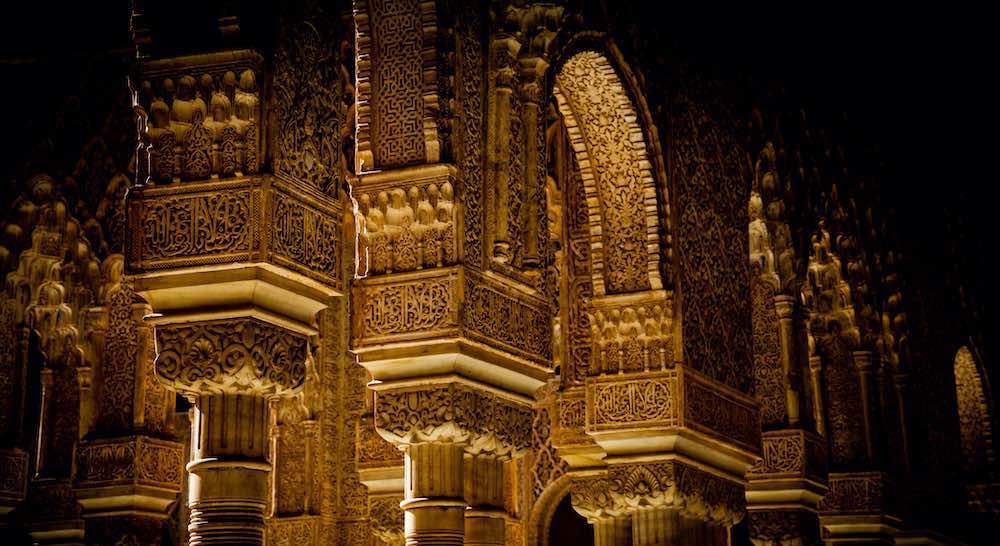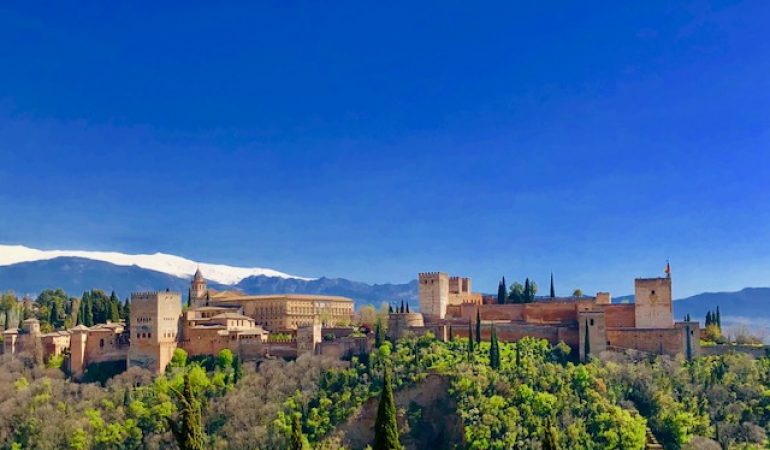The Alhambra of Granada

High above southern Spain’s expanses of rolling olive groves and vast arid plains and nestled at the foot of the snow-capped Sierra Nevada mountains lies a steep rocky outcrop that is crowned by a fairytale fortress so splendidly exotic and majestic that it rendered 16th-century Europe’s most powerful king and queen virtually speechless upon setting foot inside and laying eyes upon its magnificent interior beauty for the first time.
Built as a fortified royal residence for the generations of sultans who once reigned over this region during Spain’s nearly 800 years of Islamic rule, this splendid medieval palace has survived remarkably intact despite another 600 years of upheaval raging on around it in Spain and across Europe.
There is no other place quite like it left standing in the world today, and none like it will ever be built again. This is the great Alhambra of Granada.
After the collapse of the Roman Empire in the west, the outer reaches of the once-mighty empire were left vulnerable to roving Barbarian armies hungry for territorial spoils. In the Iberian Peninsula, Visigothic tribes moved in swiftly from the north to fill the power vacuum left by a crumbling Rome. For two centuries, the Visigoths swallowed up and ruled most of the peninsula under a successive line of Barbarian kings and warlords.
But by the early 8th century, another set of territorially ambitious tribes swept into the peninsula, this time from the south. However, these invaders were different than anything Europe had seen before.
The recent birth of a new religion far away in the Arabian Peninsula less than a century earlier had given rise to a movement to expand this new religion through conquest. Within only one generation, followers of the Islamic faith controlled territory stretching from Persia in the east to what was once Carthage in northern Africa, and within two generations their empire stretched all the way from India to the Atlantic Ocean.
In 711 AD, an army of the Umayyad Caliphate based in Damascus crossed the narrow straight separating the far western corner of north Africa from Europe and easily defeated the last Visigothic ruler of the region. Soon thereafter, the Muslim armies swept north and conquered nearly all of the Iberian Visigothic territories, ushering in what would become nearly eight centuries of Islamic rule on the Iberian Peninsula.
The Islamic settlers brought with them not only their new beliefs and advanced knowledge from the east, but also new styles of art, music, and intricate architecture. Almost immediately they would begin building new settlements with unique eastern designs, mosques for worship, and libraries and universities to continue the scientific and artistic renaissance which had already begun flourishing in their ancestral lands back east.
And for the rulers – palaces. Splendid, lavish royal residences copying the architectural styles and traditions of the region from which they hailed thousands of miles away.
Granada was not always a capital city for Spain’s Moors, as the Islamic settlers came to be known, with Seville and later Cordoba dominating the new emirate for the first 500 years after the conquest. However, Granada did eventually become a regional capital and began functioning as a principality beginning in the 11th century. By the 13th century, the ruler Muhammad I of a newly independent Granada began construction of a walled complex on the site of an abandoned Roman fortress atop a plateau overlooking the now-flourishing capital city below.
The emboldened sultan’s plans were ambitious. He called for the building of six new palaces on the site complete with a series of aqueducts, an irrigation system, and advanced hydraulics capable of supplying fresh mountain water to the site’s new gardens, bathhouses, and fountains. And as a result of the towering reddish rocky base on which the new fortress was being built and the reddish hue of the stone used to build it, residents began calling the site Al Hamra in Arabic – the Red One.
While building exteriors were rather minimalist and practical, the Sultan’s architects and designers constructed the interiors following the exquisite architectural and artistic styles of the great Islamic dynasties back east – the Umayyads of Damascus, the Abbasids of Baghdad, and the Fatimids of Cairo.
Nearly every surface inside the palaces of the Alhambra were covered in intricate decorative motifs. Since Islam forbids depictions of living beings, artists used elaborate combinations of florals, calligraphy, and geometric patterns to decorate the walls and ceilings. They also used design elements unique to Islamic architecture, such as muqarnas, a web of stalactite-shaped vertical protrusions which formed a three-dimensional honeycomb-like pattern on ceilings, domes, and doorways, and mashrabiyas, ornate latticed window coverings.

And of course, they incorporated the characteristic Islamic arch into nearly every opening or passageway. They were especially fond of scalloped arches and horseshoe arches, the latter of which became synonymous with the Moorish architectural style.
Soon, the site of the new royal residence on the plateau began morphing into a full-blown elevated city. Not only did the Sultan’s immediate and extended family take up residence there, but so too did local noble families and wealthy members of Granada’s elite who wanted to be close to the royal court and the center of power. Then there were the sultan’s ministers, advisers, and courtiers; servants, cooks, maids, and grounds staff; and thousands of soldiers garrisoned within the Alhambra’s walls.
Over the next century, successive rulers of Granada would expand on the complex that Muhammad I started to make the Alhambra even more grand and lavish. The most famous areas within the Alhambra were the palaces built for the royal family and the the great halls designed for receiving guests and dignitaries while impressing them with the emirate’s wealth and prestige.
The Comares Palace was the official residence of the royal family within the Alhambra. In the center of this palace, a long rectangular reflecting pool served as the focal point of a central courtyard called the Court of the Myrtles, around which palace rooms and chambers fan out. Reflecting onto the length of the pool from the far end of the courtyard is the Comares Tower, which houses one of the most magnificent rooms in the entire Alhambra – a throne room known as the Hall of the Ambassadors.
While the sultan conducted business in the official royal residence, he enjoyed a more leisurely life in the more private pleasure palace next door – the Palace of the Lions. Here the sultan could wander and spend time free from the intrigues of court, especially in the comfort of the royal harem which was housed here.
Or if he really wanted to get away from the stresses, pressures, and distractions of court life, Granada’s sultans could simply walk over to the Generalife, a private villa outside of the walls of the Alhambra but connected to the fortress by a series of walkways through lavish gardens lined with trees, pools, and fountains.
Life within the Alhambra’s walls for anyone lucky enough to live there was idyllic. Sealed off from the hustle and bustle of the emirate’s capital down below, the Sultan, his family, his courtiers, and the nobility lived and moved around in a world of exotic peaceful splendor. They could enjoy music while laying on large pillows in a courtyard, stroll through manicured gardens, enjoy a refreshing swim in a pristine pool filled with cool mountain water, or bask in hot steam in one of the complex’s many Arab-style bathhouses.
Within the royal palaces and gardens, you might not know whether you were on the Iberian Peninsula or the Arabian Peninsula for centuries. But beyond the Alhambra’s massive walls, gates, and towers, trouble was brewing off in the distance.
Almost as soon as the Muslim armies completed their near-sweep of the Iberian Peninsula in the 8th century, the few small territories of the mountainous northwest that had resisted conquest began organizing to push back and reconquer the peninsula for Christiandom. The movement came to be known as the Reconquista – the Reconquest – and it would take over 700 years to complete.
Despite a few early minor losses in the northwest, Muslim Moorish rulers virtually dominated the peninsula for 500 solid years. Then amid internal strife and civil war in the 13th century, the Moorish kingdom found itself significantly weakened. That’s when the expanding and emboldened Kingdom of Castille, the largest and most powerful of the northern Christian kingdoms, seized its chance and began a serious offensive.
The great capital of Cordoba fell in 1236, and then Seville soon thereafter in 1248. The Muslim lands were now reduced to the small emirate of Granada that occupied only the far south of the peninsula. The borders of Granada would remain the frontier of the two distinct civilizations for another 200 years as Castille inched its way toward the emirate’s capital city and its fortified crown jewel high above it – the Alhambra.
In 1469, Castille’s Christian king arranged for his 18-year old daughter and heir to be married to the 17-year old heir of the neighboring Christian kingdom of Aragon. The union of these two powerful and ambitious royals, Ferdinand and Isabella, would be a turning point not only for Spanish and European history, but for world history as well.
Within 10 years, both Ferdinand and Isabella would be king and queen of their respective realms, united in marriage and in purpose. And square in their sights – the Emirate of Granada. The campaign would take another decade and become known as the Granada War, but the determined Christian monarchs managed to siege and capture town after town and city after city along Granada shrinking borders.
Marbella and Ronda fell on Granada’s western frontier in 1485, followed by a notoriously bloody victory over the critical Mediterranean port city of Malaga in 1487. The next year they penetrated the eastern frontier with the capture of the town of Vera, quickly followed by Baza, Almeria, and Guadix in 1489. The Christian armies were closing in.
The snow-capped Sierra Nevadas protected the capital city’s eastern flank, while to the west the wide open vegas made any advancing army easy to see, especially from high atop the Alhambra’s towers. So Ferdinand and Isabella’s forces set up camp at a distance, cut off access to what remained of Granada, and waited.
By 1491 Granada’s last sultan and the Alhambra’s last Muslim master, Muhammad XII, also known as Boabdil, knew that all was lost and that it was only a matter of time before the great united army laying siege to Granada made its move. The sultan saw the slaughter that befell a resistant Malaga five years earlier, and he desperately wanted to avoid that same fate for the last of his people in Granada’s capital.
In spite of the visceral berating of his mother for not fighting to the death for his people and his kingdom, Boabdil finally agreed to peacefully surrender Granada and his beloved Alhambra to Ferdinand and Isabella in exchange for assurances from them that the city’s Muslim inhabitants would be able to remain, keep their homes and businesses, and freely practice their faith under their new rulers. On January 2nd, 1492, Muhammad XII rode out to Ferdinand and Isabella on horseback and in a solemn ceremony formally surrendered the keys to the Alhambra to his kingdom’s conquerors.
Legend holds that as Boabdil’s caravan was leaving the city, he turned to look back at the Alhambra one final time and began to weep. On seeing this, his bitter mother is said to have remarked, “You weep like a women over what you could not defend as a man.”
With their army in tow, Ferdinand and Isabella entered the city of Granada and rode up to the Alhambra to see for the first time the spoils of their victory. So awed and enchanted were they with the Alhambra that they made it their new royal residence and relocated the courts of their respective kingdoms to the splendid complex.
Ferdinand and Isabella loved their hard-won new home of Granada so much that they both chose it as the place they wanted their bodies to remain for eternity after their deaths, and so they do. But while these two appreciated the magnificence of the Alhambra enough to make it the center of their lives and their courts after its conquest, the same appreciation for the Alhambra could not be found in their heirs.
Ferdinand and Isabella’s grandson soon had part of one of the Alhambra’s palaces demolished to make way for a more modern Renaissance-style palace for himself, although he never used it and it was never finished. Yet the Palace of Carlos V rises today from the center of the Alhambra as a contrasting yet still beautiful and striking addition to the site.
Spain’s royal courts and the attention and patronage that came with them soon moved on to other parts of the newly unified nation, and over the next five and a half centuries the wearing of the elements and the passing of time took their toll on the once mighty royal fortress. The Alhambra faded and decayed as its luster became overshadowed by more modern European palaces constructed in the kingdom’s newer capitals.
As if the impact of centuries of neglect wasn’t enough, the occupation of the Alhambra by Napoleon’s troops from 1810 until 1812 brought about further careless damage, some of it fully intentional as French forces were forced to retreat. It would be 15 years before anyone stepped up to try to do any significant restoration work, most notably the wealthy Contreras family, a controversial effort that was welcomed by some and lambasted by others.
The dilapidated Alhambra of the early- and mid-19th century nevertheless attracted and enchanted the likes of some foreign travelers, quirky artists, architecture connoisseurs, and romantic writers. One such literary celebrity of the time, American writer Washington Irving, was even given permission to take up residence at the site by its overseer with the blessing of the Archbishop of Granada.
The time he spent in Granada, especially squatting in the abandoned rooms of the Alhambra, inspired Irving to write two more great works, Chronicles of the Conquest of Granada, published in 1829, and Tales of the Alhambra, published in 1832. The latter proved to be wildly popular in both Europe and America, leading to a resurgence in interest in Andalucia’s exotic past focused around Granada and its crown jewel – the Alhambra.
In 1844, the Spanish government stepped up and began taking a more active role in historical preservation efforts with the creation of the first Comisión de Monumentos. However, the late 19th-century restoration ideas that followed seemed to focus more on recreating the Alhambra of the fictional stories that it inspired rather than genuine historic renovation. But with the creation of a Plan General de Conservación de la Alhambra in the early 20th century, the more historically disciplined conservators eventually won out.
Today, the Alhambra of Granada is the absolute best example of a medieval Islamic fortress and palace still in existence anywhere in the world, and it has become Spain’s number one most visited historical site for tourists. While many other symbols of Spain’s eight centuries of Islamic rule are long gone, from fortresses to mosques to castles, the fact that the Alhambra was a showcase of the superiority of Islamic architecture and design once upon a time is perhaps the very thing that saved it from post-conquest destruction and allowed it to survive to the present day.


